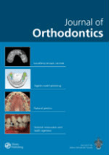
Journal of Orthodontics
Scope & Guideline
Innovating Orthodontics: Research, Insights, and Practices
Introduction
Aims and Scopes
- Clinical Orthodontics and Treatment Protocols:
The journal emphasizes evidence-based clinical practices in orthodontics, covering various treatment protocols, patient management strategies, and the effectiveness of different orthodontic appliances. - Innovative Research and Technology:
There is a strong focus on the application of new technologies in orthodontics, including 3D printing, digital treatment planning, and the use of artificial intelligence for treatment outcomes. - Patient-Centered Care and Satisfaction:
Research exploring patient perceptions, experiences, and satisfaction with orthodontic treatments is a key area, reflecting the journal's commitment to understanding the patient's voice in treatment outcomes. - Multidisciplinary Approaches:
The journal promotes interdisciplinary research that integrates orthodontics with other specialties, such as oral surgery, psychology, and general dentistry, to enhance treatment efficacy. - Public Health and Prevention:
There is an emphasis on studies related to public health issues, such as the prevalence of malocclusion and the impact of socio-demographic factors on orthodontic treatment access and outcomes.
Trending and Emerging
- Digital Orthodontics and Telehealth:
The rise of digital technologies, including telehealth and digital treatment planning, is a significant trend, reflecting the industry's move towards more accessible and efficient patient care. - Patient Experience and Involvement:
There is an increasing emphasis on research that explores patient experiences and involvement in decision-making processes, highlighting the importance of patient-centered care in orthodontics. - Interdisciplinary Treatment Approaches:
Emerging themes include the integration of orthodontics with other fields such as psychology and oral surgery, indicating a trend towards comprehensive treatment strategies that consider various aspects of patient health and well-being. - Artificial Intelligence and Machine Learning:
The application of AI and machine learning in treatment planning and outcome predictions is gaining traction, showcasing the journal's commitment to advancing the field through innovative technologies. - Sustainability in Orthodontics:
Recent publications reflect a growing interest in sustainability within orthodontic practices, addressing environmental impacts and exploring eco-friendly materials and practices.
Declining or Waning
- Traditional Fixed Appliances:
Research focusing solely on traditional fixed appliances is diminishing as interest shifts toward more innovative and less invasive treatment options such as clear aligners and digital solutions. - Longitudinal Studies on Treatment Effects:
The prevalence of long-term longitudinal studies assessing traditional orthodontic treatments has decreased, possibly due to the increasing focus on immediate clinical outcomes and patient satisfaction. - Conventional Radiographic Techniques:
There is a noticeable decline in studies utilizing conventional radiographic methods as more advanced imaging techniques like cone-beam computed tomography gain popularity for their superior diagnostic capabilities. - Orthodontic Materials Studies:
Research specifically centered on conventional orthodontic materials is waning, as the field shifts towards studies on biocompatibility and the effects of newer materials and technologies. - Surgical Orthodontics:
While still a relevant area, the frequency of publications solely focused on surgical orthodontics has reduced, likely due to the integration of surgical and orthodontic treatment approaches in broader studies.
Similar Journals

Rheumatology Advances in Practice
Bridging research and practice for better patient outcomes.Rheumatology Advances in Practice, published by Oxford University Press, is a vital open-access journal dedicated to advancing research and education in the field of rheumatology. With an E-ISSN of 2514-1775 and an impressive open access model established since 2017, this journal facilitates the dissemination of cutting-edge knowledge and innovative practices to a global audience. It has garnered recognition within the academic community, holding a Q3 classification in Rheumatology for 2023, which reflects its contribution to the evolving landscape of rheumatological research. The journal aims to present high-quality, peer-reviewed articles that explore the latest findings, advancements, and clinical applications in rheumatology, making it an essential resource for researchers, healthcare professionals, and students alike. By bridging the gap between research and practice, Rheumatology Advances in Practice plays a significant role in improving the care of patients with rheumatological conditions, promoting evidence-based approaches to clinical challenges.

International Journal of Computerized Dentistry
Advancing the Future of Dental TechnologyIntroducing the International Journal of Computerized Dentistry, a premier peer-reviewed journal published by QUINTESSENCE PUBLISHING CO INC based in Germany. This journal serves as a vital resource for researchers and practitioners in the fields of Computer Science, Dentistry, and Medicine, with a commendable H-index reflecting its influence and contribution to interdisciplinary studies. With its mission to advance knowledge and foster innovation, the journal not only focuses on cutting-edge computerized technologies in dentistry but also intersects significantly with computer science applications and medical advancements. It is recognized in the 2023 Scopus rankings as Q1 in Dentistry (miscellaneous) and Q2 in Computer Science Applications, highlighting its relevance and high standing. Available in print and online, the journal has been consistently publishing critical research since its inception in 1998, ensuring accessible, authoritative content for the academic community through to 2024 and beyond. Join fellow professionals and students in exploring the transformative impact of technology on dental practices in this distinguished journal.
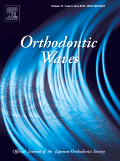
Orthodontic Waves
Exploring the latest advancements in orthodontic techniques.Orthodontic Waves, an esteemed journal published by TAYLOR & FRANCIS LTD, serves as a vital resource for professionals and researchers in the field of orthodontics. Originally established in 2006, this journal has become a key platform for disseminating innovative research and advancements in orthodontic techniques and methodologies, although it has discontinued its coverage in Scopus since 2022. Although it currently holds a Scopus rank of #19 out of 25 in the Dentistry - Orthodontics category, reflecting a 26th percentile, it continues to provide valuable insights for its community through open-access options. By fostering a comprehensive understanding of orthodontic issues and treatment pathways, Orthodontic Waves aims to bridge the gap between research and clinical practice, making it an indispensable resource for those dedicated to the enhancement of dental health.
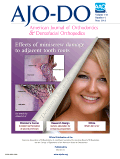
AMERICAN JOURNAL OF ORTHODONTICS AND DENTOFACIAL ORTHOPEDICS
Pioneering insights in orthodontic and dentofacial practices.The American Journal of Orthodontics and Dentofacial Orthopedics, published by Mosby-Elsevier, stands as a premier academic outlet in the field of orthodontics, boasting an impressive impact factor that reflects its influence within the community. With an HIndex indicative of its scholarly impact, this journal has carved out a significant niche since its inception in 1986, converging current research up to 2024. Notably, it ranks in the Q1 category for Orthodontics, positioning it among the top journals in the field with a Scopus rank of #6 out of 39, highlighting its contribution to advancing dental sciences. The journal aims to disseminate high-quality research, clinical studies, and reviews that explore innovative practices, treatment methodologies, and the evolving technologies in orthodontics and dentofacial orthopedics. Through its robust peer-review process, the journal provides an essential resource for researchers, practitioners, and students alike, fostering a deeper understanding and engagement with contemporary issues in orthodontic practice.

Gastroenterologie
Transforming Gastroenterological Practices Through ResearchGastroenterologie is a vital publication within the field of gastroenterology, published by Springer Heidelberg in Germany. With its ISSN 2731-7420 and E-ISSN 2731-7439, it aims to provide a comprehensive platform for the dissemination of cutting-edge research, reviews, and clinical studies focused on gastrointestinal health and disease. As a newer journal converging its content from 2022 to 2024, it is positioned to cultivate knowledge and discussions that drive innovation in gastroenterological practices. Despite its current status in the Q4 quartile and ranking 148th out of 167 in Scopus for gastroenterology, the journal is dedicated to enhancing its academic rigor and relevance, making it a noteworthy addition to the existing literature in the discipline. By choosing to publish with Gastroenterologie, authors can reach a global audience of researchers, clinicians, and students passionate about advancing the understanding of gastrointestinal conditions. This journal invites contributions that will shape future insights and foster collaborative research efforts in this critical area of medical science.

Clinical and Investigative Orthodontics
Connecting Research and Clinical ExcellenceClinical and Investigative Orthodontics is a significant peer-reviewed journal published by Taylor & Francis Ltd in the United Kingdom, focusing on the dynamic field of orthodontics. With an ISSN of 2770-5781 and E-ISSN of 2770-579X, this open-access journal facilitates a wide dissemination of research findings and innovative practices in clinical and investigational orthodontics. Since its inception in 2022, the journal has positioned itself at the forefront of orthodontic research, attaining a Category Quartile ranking of Q3 in Orthodontics for 2023, alongside a Scopus rank placing it within the 37th percentile among its peers. This underscores its relevance and commitment to advancing knowledge in the orthodontic community. Researchers, dental professionals, and students are invited to explore groundbreaking studies, clinical insights, and advancements shaping the future of orthodontics through this essential publication.
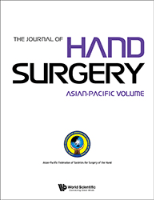
Journal of Hand Surgery-Asian-Pacific Volume
Transforming Insights into Surgical MasteryThe Journal of Hand Surgery-Asian-Pacific Volume, published by WORLD SCIENTIFIC PUBL CO PTE LTD, is an esteemed academic journal dedicated to the field of hand surgery, orthopedics, and general surgical practices. Since its inception in 2016, the journal has been committed to advancing knowledge and practice in these critical areas of medicine, serving as a platform for innovative research and clinical findings. With an impact factor that positions it in the Q3 category across several relevant fields, including Medicine (miscellaneous), Orthopedics, and Sports Medicine, it ranks within the 33rd and 22nd percentiles respectively for Surgery and Orthopedics in Scopus. The journal's scope encompasses a wide array of topics relevant to surgeons and health professionals in the Asia-Pacific region, making it an invaluable resource for ongoing education and development. Although it does not pursue open access, the journal provides essential insights and contributes significantly to the surgical community's body of knowledge. Researchers, practitioners, and students alike will find this publication an essential resource for staying abreast of emerging trends and evidence-based practices in hand surgery.
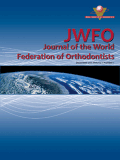
Journal of the World Federation of Orthodontists
Elevating Orthodontic Practices GloballyThe Journal of the World Federation of Orthodontists, published by Elsevier, stands as a premier platform for scholarly exchange in the field of orthodontics. With a strong ISSN of 2212-4438 and an impressive ranking as Q1 in Orthodontics for 2023, this journal is dedicated to advancing understanding and practice within the specialized discipline of orthodontics. Its current Scopus ranking positions it as 8th out of 39 in the Dentistry Orthodontics category, highlighting its impact and relevance in the field. Covering a wide range of topics related to orthodontic research, clinical practices, and innovations, the journal offers valuable insights and contributions to both established practitioners and emerging professionals. Accessible exclusively through its standard publication formats, the Journal aims to foster a global community of orthodontists and dental researchers committed to excellence and transformative practices in patient care. Whether you are a seasoned researcher or a student aspiring to make your mark, this journal serves as an essential resource for the latest advancements and discussions shaping the future of orthodontic science.

Journal of Orofacial Orthopedics-Fortschritte der Kieferorthopadie
Bridging Research and Clinical Practice in OrthodonticsJournal of Orofacial Orthopedics-Fortschritte der Kieferorthopadie, published by URBAN & VOGEL, stands at the forefront of dental research and education, specializing in the intricate domains of orthodontics and oral surgery. With its ISSN 1434-5293 and E-ISSN 1615-6714, this esteemed journal has been a vital resource since its inception in 1996, continuing to disseminate cutting-edge findings through to 2024. The journal has earned a notable impact factor and is categorized in the Q2 quartile for Medicine (miscellaneous) and Q1 quartile rankings for both Oral Surgery and Orthodontics, reflecting its high relevance and influence within the academic community. The journal is highly regarded within the Scopus rankings, holding the 7th and 17th positions in Orthodontics and Oral Surgery respectively, indicating its prestigious standing among its peers. Despite being a subscription-based publication, it remains an essential forum for researchers, practitioners, and students alike, providing invaluable insights into the latest advancements in orofacial orthopedics. With its base in Munich, Germany, the journal not only contributes to academic discourse but also drives practical innovations in the field, making it an indispensable resource in enhancing patient care and advancing professional knowledge.

BULLETIN DU CANCER
Transforming cancer care with groundbreaking studies.BULLETIN DU CANCER is a pivotal academic journal dedicated to the field of oncology, providing a platform for innovative research and insights into cancer treatment and diagnostics. Published by Elsevier Masson, Corp Off in France, this journal has been a part of the scientific community since 1966, and is committed to sharing critical findings that influence clinical practices and improve patient outcomes. Despite its recent rankings placing it in the Q4 category for Cancer Research and Q3 for Hematology and other related fields, BULLETIN DU CANCER remains essential for those interested in the latest developments in cancer biology and treatment methodologies. With an emphasis on both basic and clinical research, it serves as a valuable resource for researchers, healthcare professionals, and students seeking to deepen their understanding in various dimensions of oncology. This journal is particularly relevant as it continues to spotlight emerging research trends and supports the global imperative to combat cancer more effectively.